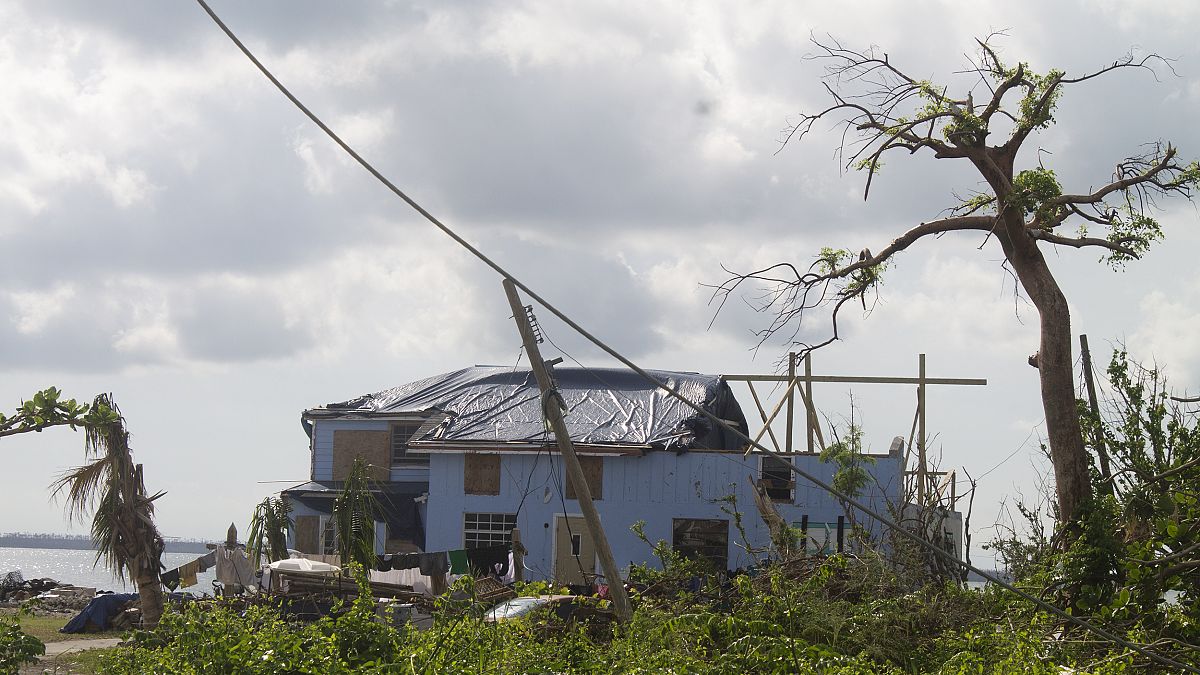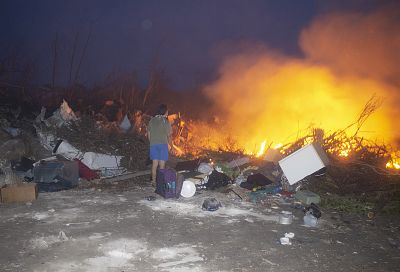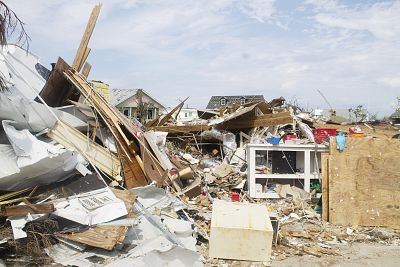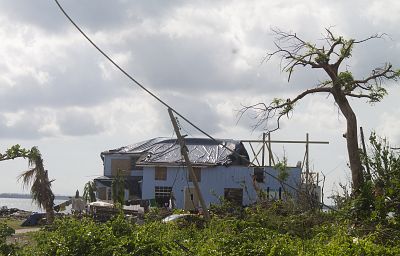Residents on Green Turtle Cay say they haven't received help from the government since the hurricane and have resorted to burning their trash in an attempt to prevent disease.
GREEN TURTLE CAY, Bahamas — Two months after Hurricane Dorian devastated this island nation, Green Turtle Cay residents are burning the debris left from the worst natural disaster in Bahamian history.
The 185-mph winds pounded Green Turtle Cay, a 3-mile-long barrier island, for more than 30 hours — flattening nearly half the structures and littering the streets with what used to be homes and businesses. In total, estimates suggest Dorian left 1.3 billion pounds of debris in its wake, which could cost $74 million to remove, according to the Ministry of Health.
"Our dump was completely full. The island had no choice but to burn it before garbage piled up," said Dr. Pam Mobley, a retired anesthesiologist from Knoxville, Tennessee, who lost her vacation home in Green Turtle. She stayed after Dorian to stock and operate the island's only medical clinic.
Mobley fears that without proper prevention efforts, disease could spread through the population, which numbers about 500 and with families sharing cramped spaces in whatever dry homes are still standing.
The resulting trash fire has created a polluted haze near the dump, where pigs and cats rummage for contaminated food. While these animals are not a threat to the community, disease-carrying rodents and bugs could prove deadly.
"Rats and mosquitoes are a big deal. If we do not get that right, then we are really in trouble," Minister of Health Dr. Duane Sands told NBC News.
The Bahamas is always on alert for vector-borne diseases such as cholera, scabies, dengue fever and zika. Researchers are sampling mosquito populations on the islands to flag the emergence of these diseases, with early detection being a top priority.
The Ministry of Health says they have seen no spike of symptoms for vector-borne illnesses since the storm but remain cautious.
The ministry discourages any island from burning debris, and although rumors circle Green Turtle Cay of a barge arriving to help, timelines remain unknown despite the need being immediate.
Burning trash can be deadly since dioxins from house fires are considered extremely toxic, according to the Centers for Disease Control and Prevention, which warns that smoke inhalation from household appliances, such as washers and dryers, and asbestos materials can cause irreparable harm.
Jonathan Grigg, professor of environmental medicine at the Queen Mary University of London, told NBC News that this type of pollution could increase the risks of chronic lung disorders, especially in children, on an island where families without power or running water are fighting to stay healthy.
The nonprofit Samaritan's Purse has begun chipping away at the Bahamas waste issue by hauling 89,100 cubic feet of debris from Man-O-War Cay — filling 11 barge trips. It has also placed crews on neighboring Elbow Cay and Great Abaco, but has no immediate plans to aid Green Turtle Cay.
Dorian presents complicated health issues for the Ministry of Health, which is plagued by hurricane Dorian-related infrastructure problems and remains understaffed because doctors and nurses have been displaced, Sands said. This has left residents turning to American nonprofits for long-term recovery help.
From HIV testing in emergency shelters to addressing post-traumatic stress disorder, Sands said recovery is a marathon, not a sprint, and could impact generations of Bahamians.
'Apocalyptic' aftermath
Green Turtle Cay recorded no deaths during Dorian, but only a 10-minute boat ride across the Sea of Abaco, the island of Great Abaco is facing an apocalyptic aftermathin which military personnel are still actively searching for bodies.
The Royal Bahamian Police says the death toll from Dorian is 67, but Sands said it is likely hundreds are dead on Great Abaco. Locals tell NBC News that as many as 3,500 undocumented Haitian refugees were killed in the city of Marsh Harbour, which was leveled by a 25-foot storm surge.
With more than 75,000 Bahamians affected, government ministries are left scrambling to figure out how to cover the estimated $7 billion cost of recovery — an amount that dwarfs the island nation's annual operating budget of $2.6 billion.
The Bahamas' Department of Social Services said more than 787 people remain in six shelters on Great Abaco. The Bahamas Red Cross said it has served more than 4,700 families as of mid-October, by supplying hygiene items, kitchen supplies, blankets, buckets, and jerrycans, including to 50 households on Green Turtle Cay.
In the nation's capital of Nassau, officials said the archipelago is a victim of extreme weather due to climate change and needs to become a priority for environmental activists since rising sea levels are expected to further intensify the impact of hurricanes.
"Island nations illustrate the iron law of climate change: the less you did to cause it, the more you suffer," Bill McKibben, the co-founder of the environmental advocacy group 350.org, wrote in an email to NBC News. "Nations are starting to disappear."
American response on Green Turtle Cay
Residents on Green Turtle said they have been ignored by the National Emergency Management Agency (NEMA) and have turned to American nonprofits for long-term recovery help.
"This was by far the worst storm in my lifetime, but the United States has responded incredibly," Lonnie Lowe, 66, an eighth generation Bahamian to live on Green Turtle Cay, said. The retired builder said the island is thankful for American aid, even though Green Turtle was founded by British loyalists.
NEMA doesn't deny most of its resources are tied up in the larger islands of Great Abaco and Grand Bahama and said the only logistical chance it has to help smaller islands is with international partnerships.
"Nassau's response has been zero," Patrick Sawyer, who plans to rebuild Lowe's Food Store and Gift Shop with his wife, Minerva, said. The shop has been a community staple for more than 70 years and was destroyed by the storm.
American nonprofits such as Water Mission, the United Aid Fund (UAF) and World Central Kitchen (WCK) have been instrumental in providing drinkable water and meals throughout the Abacos, says Brad Carlton, 61, the captain of a private boat that brought more than 5,000 pounds of food from Florida to Green Turtle Cay after Dorian hit.
Much of the American effort has also been focused on injecting capital into staple restaurants on Green Turtle in the hopes of growing the work force and stabilizing supply and demand issues that have inflated the price of a single onion to $4, for instance.
Locals also say generators have become an enormous expense with fuel prices remaining at $5 per gallon — meaning a refrigerator can cost more than $500 a month to run.
The Bahamian economy is highly dependent on tourism, which employs nearly half the labor force. Green Turtle relies on golf cart rentals, boat charters and restaurants as the economic pulse. All that ground to a halt when Dorian hit, leaving most islanders out of work.
Prime Minister Hubert Minnis traveled to Green Turtle Cay at the end of October to announce the formation of the Bahamian Disaster Reconstruction Authority, as well as making the Abacos tax-free zones until June 2020, in an effort to stimulate local businesses.
Key West Cares, the sister city of Green Turtle Cay, has hired locals to work with construction-focused American nonprofits such as Cypress Missions and Heart 9/11 to rebuild the community with material brought by the Green Turtle Foundation.
The Green Turtle Foundation is a Florida-based nonprofit that has raised more than $175,000 to ship everything from plywood to mobile homes to the island by barge.
Meanwhile, the well-meaning donations that arrive sometimes miss the mark. Green Turtle residents joke that enough toothbrushes have been donated for every tooth on the island, as well as thousands of diapers for only a few babies among the residents on the cay.
"If it wasn't for America, we would be dead," William Curry, a 64-year-old fisherman who has lived on Green Turtle all his life, said. "Our government hasn't given us anything, not a bottle of water."



